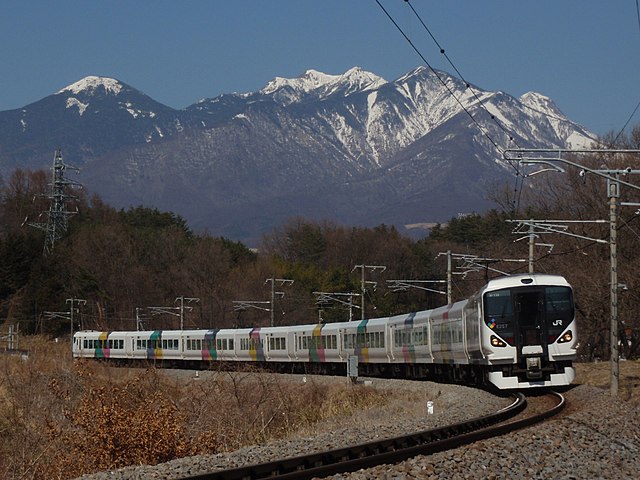Edit 3 October 2019: Updated prices to reflect the increase in Japan's national sales tax.
Edit 24 November 2019: Earlier this year, the "Super Azusa" name has been retired and all its trains were renamed as "Azusa".
 |
| An E353-series Super Azusa train at Matsumoto Station. Taken on Saturday, 19 May 2018. |
| Name | Start Station | End Station(s) | Time* | Max. Frequency** |
| Kaiji | Shinjuku | Kofu | 1 hour 45 minutes | 1 per hour |
| Azusa | Shinjuku | Matsumoto | 3 hours | 1 per hour |
| Super Azusa | Shinjuku | Matsumoto | 2 hours 30 minutes | 1 per hour |
**Departures are based on April 2017 schedules and are subject to change.
The Kaiji only goes as far as Kofu Station, whereas the Azusa makes the full journey from Shinjuku to Matsumoto, with some services (former Super Azusa trains) making fewer stops. Some trains go even farther, with some Kaiji and one Azusa per day starting from Tokyo, and one other Azusa ending at Minami-Otari. For those looking to transfer to the Fujikyu line, at Otsuki Station, only the Kaiji and some Azusa services stop there.
| Name (English) | Name (Japanese) | Line | Kaiji | Azusa |
| Tokyo | 東京 | JR Chuo | O | O |
| Shinjuku | 新宿 | X | X | |
| Mitaka | 三鷹 | X | I | |
| Tachikawa | 立川 | X | X | |
| Hachioji | 八王子 | X | X | |
| Otsuki | 大月 | X | O | |
| Enzan | 塩山 | X | O | |
| Yamanashi-shi | 山梨市 | X | O | |
| Isawa-Onsen | 石和温泉 | X | O | |
| Kofu | 甲府 | X | X | |
| Nirasaki | 韮崎 | I | X | |
| Kobuchizawa | 小淵沢 | I | X | |
| Fujimi | 富士見 | I | O | |
| Chino | 茅野 | I | X | |
| Kami-Suwa | 上諏訪 | I | X | |
| Shimo-Suwa | 下諏訪 | I | O | |
| Okaya | 岡谷 | I | X | |
| Shiojiri | 塩尻 | I | X | |
| JR Shinonoi | ||||
| Matsumoto | 松本 | I | X | |
| JR Oito | ||||
| Toyoshina | 豊科 | I | O | |
| Hotaka | 穂高 | I | O | |
| Shinano-Omachi | 信濃大町 | I | O | |
| Hakuba | 白馬 | I | O | |
| Minami-Otari | 南小谷 | I | O |
X: All trains stop at this station.
O: Some trains stop at this station.
I: No trains stop at this station.
 |
| The main keep of Matsumoto Castle, accessible from Matsumoto Station. Taken on Saturday, 19 May 2018. |
- Shinjuku: A bustling transportation and entertainment hub in Tokyo.
- Mitaka: Location of the Studio Ghibli Museum.
- Otsuki: Gateway to the Fuji Five Lakes via the Fujikyuko Line.
- Kofu: The terminus of the Kaiji.
- Kobuchizawa: The last stop in Yamanashi Prefecture, and the last stop covered by the Tokyo Wide Pass.
- Chino: Gateway to the Takato Castle ruins, one of Japan's best cherry-blossom spots.
- Matsumoto: City with a long-standing castle.
- Shinano-Omachi: The start of the Tateyama-Kurobe Alpine Route.
- Hakuba: A ski resort used during the 1998 Winter Olympics.
- Minami-Otari: Where JR East's coverage area ends and JR West's begins.
| Total Cars | Non-Reserved Cars | Reserved Cars | Green Cars |
| 12 | 4 (Cars #3-6) | 5½ (Cars #1-2, 7-9, 10-12) | ½ (Car #9) |
Tips
- For those using the Azusa or Kaiji to get to the Fuji Five Lakes, the Japan Rail Pass and most JR East passes will only cover those trains, and not the Fujikyu line. The exception is the Tokyo Wide Pass, which covers both lines.
- The Tokyo Wide Pass and Tohoku Area Pass only cover journeys on the Azusa as far as Kobuchizawa, the last stop in Yamanashi Prefecture. If you are using a Tokyo Wide Pass, you will have to pay for any sections travelled beyond that point, starting from Kobuchizawa. For example, going the rest of the way to Matsumoto would cost an extra ¥2,190 for reserved tickets.
- "Azusa" (あずさ) is named after the Azusa River in Matsumoto. The name was first used for express services in 1957-1960, then for the current limited express in 1966.
- "Kaiji" (かいじ) is named after Kai Province (甲斐国, Kai no kuni), the old counterpart to modern-day Yamanashi Prefecture. The name was first used for semi-express services in 1961-1965, then express services in 1966-1986, and finally as the current limited express in 1988.
- The "Super Azusa" (スーパーあずさ, Sūpā Azusa) service was introduced in 1994. It made fewer stops than the Azusa, and used more advanced trainsets. On 16 March 2019, the Super Azusa name was retired and all its trains were rebranded as Azusa.
 |
| An E257-series train, formerly used by Azusa and Kaiji trains until 2019, in front of the Yatsugatake Mountains, between Nagasaka and Kobuchizawa stations. By Cassiopeia sweet [Public domain], from Wikimedia Commons |

